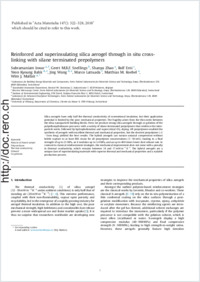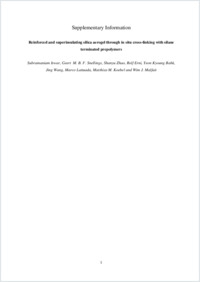Reinforced and superinsulating silica aerogel through in situ cross-linking with silane terminated prepolymers
- Iswar, Subramaniam Laboratory for Building Energy Materials and Components, Empa, Dübendorf, Switzerland - University of Fribourg, Department of Chemistry, Fribourg, Switzerland
- Snellings, Geert M. B. F. Sustainable Innovation Department, Recticel NV, Wetteren, Belgium
- Zhao, Shanyu Laboratory for Building Energy Materials and Components, Empa, Dübendorf, Switzerland
- Erni, Rolf Electron Microscopy Center, Swiss Federal Laboratories for Materials Science and Technology, Empa, Dübendorf, Switzerland
- Bahk, Yeon Kyoung Institute of Environmental Engineering, ETH Zurich, Switzerland - Laboratory for Advanced Analytical Technologies, Swiss Federal Laboratories for Materials Science and Technology, Empa, Dübendorf, Switzerland
- Wangd, Jing Laboratory for Advanced Analytical Technologies, Swiss Federal Laboratories for Materials Science and Technology, Empa, Dübendorf, Switzerland
- Lattuada, Marco University of Fribourg, Department of Chemistry, Fribourg, Switzerland
- Koebel, Matthias M. Laboratory for Building Energy Materials and Components, Empa, Dübendorf, Switzerland
- Malfait, Wim J. Laboratory for Building Energy Materials and Components, Empa, Dübendorf, Switzerland
-
01.04.2018
Published in:
- Acta Materialia. - 2018, vol. 147, p. 322–328
English
Silica aerogels have only half the thermal conductivity of conventional insulation, but their application potential is limited by the poor mechanical properties. The fragility arises from the thin necks between the silica nanoparticle building blocks. Here, we produce strong silica aerogels through co-gelation of the polyethoxydisiloxane precursor with a variety of silane terminated prepolymers that reinforce the inter- particle necks, followed by hydrophobization and supercritical CO2 drying. All prepolymers enabled the synthesis of aerogels with excellent thermal and mechanical properties, but the shortest prepolymer (∼2–3 nm long) yielded the best results. The hybrid aerogels can sustain uniaxial compression without brittle rupture to at least 80% strain for all prepolymer concentrations (5–50 wt%), leading to a final strength of up to 21 MPa, an E modulus up to 3.4 MPa, and an up to 400 times lower dust release rate. In contrast to classical reinforcement strategies, the mechanical improvement does not come with a penalty in thermal conductivity, which remains between 14 and 17 mW m−1 K−1. The hybrid aerogels are a unique class of superinsulating materials with superior thermal and mechanical properties and a scalable production process.
- Faculty
- Faculté des sciences et de médecine
- Department
- Département de Chimie
- Language
-
- English
- Classification
- Chemistry
- License
-
License undefined
- Identifiers
-
- RERO DOC 309465
- DOI 10.1016/j.actamat.2018.01.031
- Persistent URL
- https://folia.unifr.ch/unifr/documents/307121
Other files
Statistics
Document views: 112
File downloads:
- pdf: 289
- Supplementary material: 200

